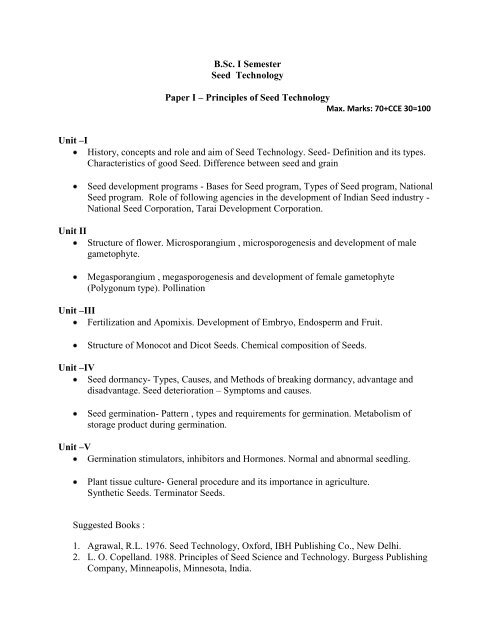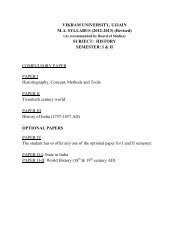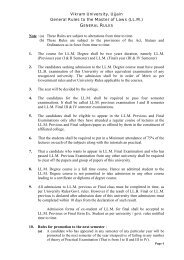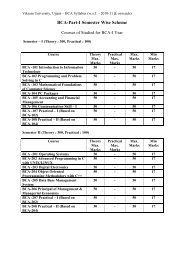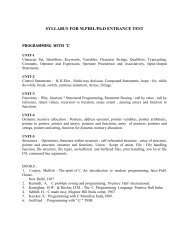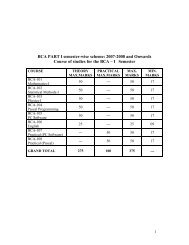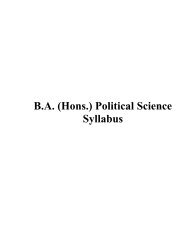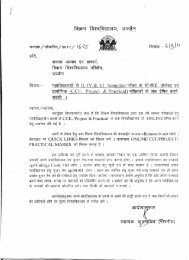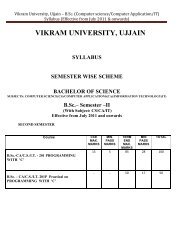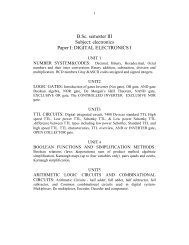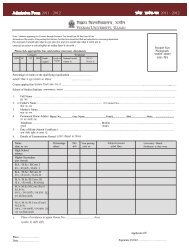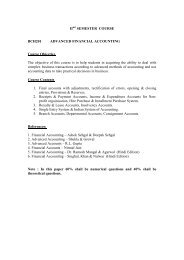B.Sc. I Semester Seed Technology Paper I – Principles of Seed ...
B.Sc. I Semester Seed Technology Paper I – Principles of Seed ...
B.Sc. I Semester Seed Technology Paper I – Principles of Seed ...
You also want an ePaper? Increase the reach of your titles
YUMPU automatically turns print PDFs into web optimized ePapers that Google loves.
B.<strong>Sc</strong>. I <strong>Semester</strong><strong>Seed</strong> <strong>Technology</strong><strong>Paper</strong> I – <strong>Principles</strong> <strong>of</strong> <strong>Seed</strong> <strong>Technology</strong>Max. Marks: 70+CCE 30=100Unit –IHistory, concepts and role and aim <strong>of</strong> <strong>Seed</strong> <strong>Technology</strong>. <strong>Seed</strong>- Definition and its types.Characteristics <strong>of</strong> good <strong>Seed</strong>. Difference between seed and grain<strong>Seed</strong> development programs - Bases for <strong>Seed</strong> program, Types <strong>of</strong> <strong>Seed</strong> program, National<strong>Seed</strong> program. Role <strong>of</strong> following agencies in the development <strong>of</strong> Indian <strong>Seed</strong> industry -National <strong>Seed</strong> Corporation, Tarai Development Corporation.Unit IIStructure <strong>of</strong> flower. Microsporangium , microsporogenesis and development <strong>of</strong> malegametophyte.Megasporangium , megasporogenesis and development <strong>of</strong> female gametophyte(Polygonum type). PollinationUnit –IIIFertilization and Apomixis. Development <strong>of</strong> Embryo, Endosperm and Fruit.Structure <strong>of</strong> Monocot and Dicot <strong>Seed</strong>s. Chemical composition <strong>of</strong> <strong>Seed</strong>s.Unit –IV<strong>Seed</strong> dormancy- Types, Causes, and Methods <strong>of</strong> breaking dormancy, advantage anddisadvantage. <strong>Seed</strong> deterioration – Symptoms and causes.<strong>Seed</strong> germination- Pattern , types and requirements for germination. Metabolism <strong>of</strong>storage product during germination.Unit –VGermination stimulators, inhibitors and Hormones. Normal and abnormal seedling.Plant tissue culture- General procedure and its importance in agriculture.Synthetic <strong>Seed</strong>s. Terminator <strong>Seed</strong>s.Suggested Books :1. Agrawal, R.L. 1976. <strong>Seed</strong> <strong>Technology</strong>, Oxford, IBH Publishing Co., New Delhi.2. L. O. Copelland. 1988. <strong>Principles</strong> <strong>of</strong> <strong>Seed</strong> <strong>Sc</strong>ience and <strong>Technology</strong>. Burgess PublishingCompany, Minneapolis, Minnesota, India.
3. John Robson Thomson. 1979. An introduction to seed technology. Publisher Wiley.4. Uma Shankar Singh. 2008. <strong>Seed</strong> <strong>Technology</strong> and <strong>Seed</strong> Pathology. Anmol PublicationsPvt Ltd.5. Bewley, J.D., and L. Black. 1982. Physiology and Biochemistry <strong>of</strong> seeds in relation togermination, Vol.1 and Vol.11, Springer-Verlag, Berlin Heiderbe, New York.6. Jaima Kigel, J. and G. Galili, 1997. <strong>Seed</strong> development and germination, Marcel Dekker,New York.Practicals : Based on theory papers.<strong>Semester</strong> –I<strong>Sc</strong>heme <strong>of</strong> Practical ExaminationS.No. Experiment Marks12345MajorMinor – IMinor – IISpottingSessional151051010Total 50
B.<strong>Sc</strong>. II <strong>Semester</strong><strong>Seed</strong> <strong>Technology</strong><strong>Paper</strong> II - <strong>Seed</strong> production and Economically Important Families and WeedsMax. Marks: 70+CCE 30=100Unit IGeneral <strong>Principles</strong> and Methods <strong>of</strong> <strong>Seed</strong> Production. Maintenance <strong>of</strong> Breeder’s seed –Methods in self fertilized crops, methods in cross fertilized crops.Unit IIDevelopment, trial and release <strong>of</strong> variety. Methods <strong>of</strong> seed production for cereals –Wheat and MaizeMethods <strong>of</strong> seed production for pulses and oil crops – Gram, Soybean, Groundnut,Mustard and Sunflower.Methods <strong>of</strong> seed production for vegetables and forage crops – Tomato, Potato, Onion,Berseem and Lucerne.Unit IIIMethods <strong>of</strong> seed production in fibers and sugar producing crops – Cotton, Juice,Sugarcane, Sugar beet.Study <strong>of</strong> following families with special reference to seed structure, floral structure andeconomic importance – Brassicaseae and Asteraceae.Unit IVStudy <strong>of</strong> following families with special reference to seed structure, floral structure andeconomic importance – Malvaceae and Solonaceae.Unit VStudy <strong>of</strong> following families with special reference to seed structure, floral structure andeconomic importance – Fabaceae and Poaceae.Study <strong>of</strong> following weeds <strong>of</strong> local crops – Ageratum conyzoides, Chenopodium album,Amaranthus virides, Cuscuta reflexa, Argemone maxicana and Cynadon dactylon.Study <strong>of</strong> following weeds <strong>of</strong> local crops –Celosia argantia, Eclipta alba, Euphorbiahirta, Oxalis corniculata, Solanum xanthocarpum, Parthenium histerophorus.Suggested Books :1. Kozlowski, T.T. 1972. <strong>Seed</strong> Biology, Vol. 1, Academic Press, London.2. Jaima Kigel, J. and G. Galili. 1997. <strong>Seed</strong> Development and Germination. Marcel Dekker,New York.
3. Agrawal, R.L. 1976. <strong>Seed</strong> <strong>Technology</strong>, Oxford, IBH Publishing Co., New Delhi.4. Kalivaratharaju, T.V. 1988. <strong>Seed</strong> Production <strong>Technology</strong> Manual, Dept. <strong>of</strong> Agriculture,Government <strong>of</strong> Tamil Nadu.Practicals : Based on theory papers.<strong>Semester</strong> –II<strong>Sc</strong>heme <strong>of</strong> Practical ExaminationS.No. Experiment Marks12345MajorMinor – IMinor – IISpottingSessional151051010Total 50
B.<strong>Sc</strong>. III <strong>Semester</strong><strong>Seed</strong> <strong>Technology</strong><strong>Paper</strong> – III Plant breeding in relation to seed <strong>Technology</strong>Max. Marks: 70+CCE 30=100Unit IPlant breeding - Introduction, Objectives, Activities and Important achievements. Modes<strong>of</strong> pollination in self – pollinated crops and cross – pollinated crops.Unit IISelf incompatibility - definition types, mechanism and application. Male sterilitydefinition, types, methods, induction and application.Germplasm and its conservation – Introduction, germplasm collection, center <strong>of</strong> originand diversity. <strong>Seed</strong> banks and types <strong>of</strong> seed collections.Plant Introduction – definition, types, procedure, merits and demerits.Selection – definition, types, methods, merits and demerits.Unit IIIHybridization – definition, types and objectives. Techniques <strong>of</strong> hybridization -Selection and evaluation <strong>of</strong> parents, Emasculation, Bagging and tagging, Pollination,Collection and storage <strong>of</strong> F1 seeds, Growing <strong>of</strong> F1 generation.Improvement in self pollinated crops through hybridization, application, procedure,merits and demerits and achievements <strong>of</strong> pedigree and bulk.Unit IVHeterosis – definition, types, basis and economic uses. Uses <strong>of</strong> heterosis in cropimprovement.Hybrid, synthetic and composite varieties. Mutation breeding – mutagens, procedure,precautions, application and achievements.Unit VPlant breeding for disease resistance. Plant breeding for insect resistance.Plant breeding work done in following crops-Wheat, Maize, Rice, Cotton, Potato,Sugarcane.Suggested Books :
4. International <strong>Seed</strong> Testing Association. 1979. Hand Book <strong>of</strong> <strong>Seed</strong>ling Evaluations<strong>Sc</strong>ientific Publishers, Jodhpur.5. Nema, N.P. 1987. <strong>Principles</strong> <strong>of</strong> <strong>Seed</strong> Certification and Testing, Allied Publishers Pvt.Ltd., New Delhi.6. Anon. 1965. Field Inspection Manual and Minimum <strong>Seed</strong> Certification Standards,NSC Publication, New Delhi.Practicals : Based on theory papers.<strong>Semester</strong> –IV<strong>Sc</strong>heme <strong>of</strong> Practical ExaminationS.No. Experiment Marks12345MajorMinor – IMinor – IISpottingSessional151051010Total 50
B.<strong>Sc</strong>. V <strong>Semester</strong><strong>Seed</strong> <strong>Technology</strong><strong>Paper</strong> – <strong>Seed</strong> protectionMax. Marks: 70+CCE 30=100Unit IHistory, objective and importance <strong>of</strong> seed technology. <strong>Seed</strong> borne diseases.Mechanism <strong>of</strong> infection, Factors affecting seed infection, Important epidemic seed borndiseases.<strong>Seed</strong> borne pathogens. Control measures for seed borne pathogens.Unit II<strong>Seed</strong> health test. Dry seed examination. Storage fungi and their harmful effect on seeds.Factors affecting storage fungi. Isolation and identification <strong>of</strong> storage fungi. Controlmeasures for storage fungi.Unit IIIMycotoxins - Types and effect, Mycotoxins producing fungi. Factors affectingmycotoxin production.Mycotoxin – Detection <strong>of</strong> mycotoxins, Control measures for mycotoxins.Unit IVRole <strong>of</strong> insects in agriculture. Harmful insects <strong>of</strong> crop plants.Unit VBeneficial insects <strong>of</strong> crop plants. Outline <strong>of</strong> insect control.Insecticides, fumigants and method <strong>of</strong> fumigation. Insecticidal poisoning and theirtreatment.Insecticidal machinery, Integrated pest management.Suggested Books1. Neergaard,P. 1987. <strong>Seed</strong> Pathology Vol.I and II, Mc Millan Publication.2. Agarwal, V.K. 1988. <strong>Principles</strong> <strong>of</strong> <strong>Seed</strong> Pathology CRC Publication. G.B.P.U.A. & T.,Pantnagar, U.P., India.3. Maude,R.B. 1995. <strong>Seed</strong> - borne diseases and their control, Horticultural ResearchInternational Wellesbourne, U.K.4. Kwoloski. <strong>Seed</strong> Ecology. Vol.II & III.
Practicals : Based on theory papers.<strong>Semester</strong> –V<strong>Sc</strong>heme <strong>of</strong> Practical ExaminationS.No. Experiment Marks12345MajorMinor – IMinor – IISpottingSessional151051010Total 50
B.<strong>Sc</strong>. VI <strong>Semester</strong><strong>Seed</strong> <strong>Technology</strong><strong>Paper</strong> –<strong>Seed</strong> processing, storage and marketing.Max. Marks: 70+CCE 30=100Unit IConcept, principles and importance <strong>of</strong> seed processing. Methods <strong>of</strong> seed conditioning.Equipment’s used for seed conditioning.. Layout <strong>of</strong> a seed processing plants.Unit II<strong>Seed</strong> Drying- principles, advantages and methods. <strong>Seed</strong> dryers.<strong>Seed</strong> cleaning methods, separation and grading. <strong>Seed</strong> conveyors and elevators. <strong>Seed</strong>Blending.Unit IIIDefinition, advantage and kinds <strong>of</strong> seed treatments. Methods <strong>of</strong> <strong>Seed</strong> treatment -mechanical, physical and chemical.<strong>Seed</strong> treating chemicals. <strong>Seed</strong> treating equipmentsUnit IVMethods and advantages <strong>of</strong> seed bagging. <strong>Principles</strong> and methods <strong>of</strong> seed storage.Pest problems and their treatment during seed storage.Unit VObjective and importance <strong>of</strong> seed marketingMajor components <strong>of</strong> seed marketing-1. Forecasting <strong>of</strong> seed demand,2. Supply <strong>of</strong> seed3. <strong>Seed</strong> marketing structure4. <strong>Seed</strong> sales pro motion,5. Determination <strong>of</strong> cost <strong>of</strong> seed production and seed pricing.Suggested Books1. Agrawal, R.L. 1996. <strong>Seed</strong> <strong>Technology</strong>. Oxford publication, New Delhi.2. Barton, L.V. 1985. <strong>Seed</strong> preservation and longevity, International Books and Periodicalssupply service, New Delhi.3. Justice, O.L. and L.N. Bass, 1978. <strong>Principles</strong> and practices <strong>of</strong> seed storage, Castle HousePublications Ltd., Great Britain.4. Koslowski, T.T. 1972. <strong>Seed</strong> Biology, Vol. Ill, Academic Press, New York and London.
5. N.R. Brandenberg, 1961. Why and how are seeds dired? The year book <strong>of</strong> Agriculture, USDA,Washington, D.C., P. 295.6. R.K. Mathews, G.B. Welch, J.C. Delouche and G.M. Dougherty, 1969. Drying, processingand storage <strong>of</strong> corn seed in tropical and subtropical regions, Proc. Am. Agric. Eng. St. Joseph,Mich. <strong>Paper</strong> No. 69-67. 1969.


